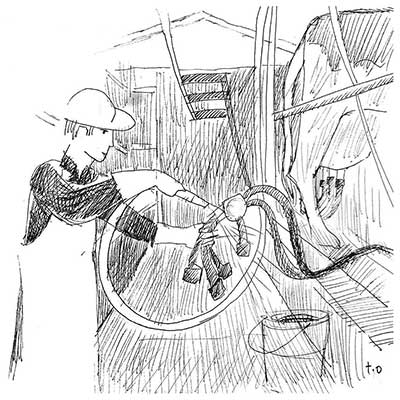 |
| Drawing by Toki Oshima |
By Jacki Martinez Perkins
The dairy industry has found itself in the same position that many small businesses encountered during the past few decades. Small farms are being driven out of business by the natural progression of capitalism. Large-scale dairies can operate at lower costs per cow, negotiate their price points and own the capital that lending establishments require to take them seriously.
When the organic movement came to the dairy industry, many saw it as the savior of the small farm, with its better pay price and with the belief that available grazing space would limit herd size. In the years since, its popularity has become its own worst enemy, with consumers demanding a more-affordable retail price and lacking the understanding of what makes that price. Many operations have struggled to meet the fluctuating demands of the market, causing them to lose time, money and sanity. I asked several farmers who have been in the business through good pay prices and bad about their decision-making process and their sweet spot.
One of the larger organic dairy farms in Maine has traditionally found that its available grazing land has been the major limiting factor. While the market was still intact, the owner was approached with a proposal to supply a new dairy with bred heifers. Meanwhile the organic milk market found itself looking to cut costs, and Maine was an area in which further expansion would not have been cost-effective, so the enterprise fell through, leaving the farmer in the position of having excess cattle. Needing to make a decision and watch his bottom line, the producer was able to select and keep the cows in his herd that had the potential to produce high-fat milk. To ensure that the cows could achieve the highest possible solids content in their milk, the farm employs a nutritionist to balance the daily ration of the cows. The combined effort of breed selection and ration balancing increased the butterfat content of the milk from 3.9 to 4.7 percent, herd average – a delightful surprise.
Another farmer lost his wholesaler contract and needed to focus on bottling and marketing milk himself. He chose to reduce his herd size to match his market, and to cut costs by eliminating what little feed concentrates the cows were eating. By cutting grain from the cows’ diet, the producer also was able to switch to milking just once a day rather than twice, which the industry has always advocated. He allows calves to stay with dams for up to a week after birth and has seen no problems with mastitis or discomfort. By changing his management practices to suit his needs, he had more time for marketing and delivering milk. This producer has always been partial to the Jersey breed, and by bucking the trend for a high-production breed, he could take advantage of a marketing trend by advertising the A2 status of his herd. (A2 milk mostly lacks the A1 form of β-casein proteins and has mostly the A2 form, so it may be easier for some people to digest.)
These two farms are fortunate to have a new generation ready to take over the enterprise. The third farmer I questioned is now retired, and the farm was sold to a land trust, but he had valuable input based on his experiences with market trends, with what worked for his operation and with not letting anyone tell him what to do. When he acquired his operation from his father in the 1970s, industry standards encouraged farmers to overstock their barns by 30 percent, reasoning that if some cows were sleeping, others would be eating, and this would maximize the space that the cows were using. This farmer quickly found that life was hard, bills were high, and cows were unhealthy at the industry stocking rate. He reduced his herd to fit the exact number of stalls in his barn, and his problems were solved. He was also able to take advantage of the organic market when it came to Maine, because he reasoned that grass was free feed, and he never ran a confinement operation. This producer, although retired, is also a huge supporter of periodically selling the milking herd, taking a step back, taking a deep breath, and getting a new perspective on how the operation works and how to improve it.
I spoke only with organic producers, but I have worked on and witnessed conventional operations where the owner dreamed of reaching a certain size milking herd without updating infrastructure to handle the extra cows. There aren’t enough vaccines or antibiotics invented to combat stress related to overpopulation, and often mortality rates rise until the natural balance reasserts itself.
If you find recurring problems, assess your needs, seek assistance, and make the changes that benefit your operation. Every farm is as unique as the farmer running it; something that works for the majority may not work for you. And, remember: None of us farms to get rich; we’re here because we love it.
Jacki is MOFGA’s organic dairy and livestock specialist. You can contact her at [email protected].
